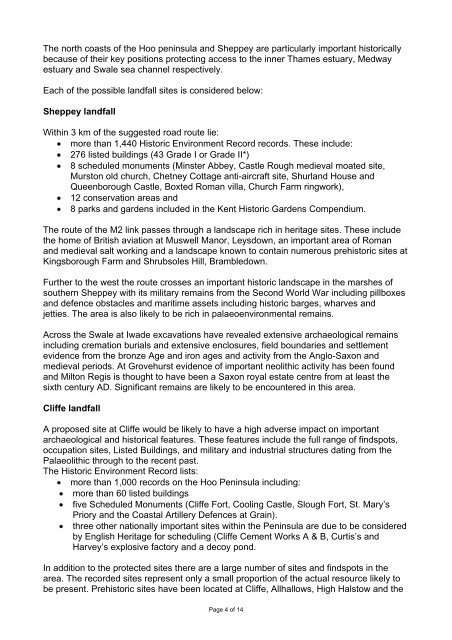1. Ecological objections - London
1. Ecological objections - London
1. Ecological objections - London
You also want an ePaper? Increase the reach of your titles
YUMPU automatically turns print PDFs into web optimized ePapers that Google loves.
The north coasts of the Hoo peninsula and Sheppey are particularly important historically<br />
because of their key positions protecting access to the inner Thames estuary, Medway<br />
estuary and Swale sea channel respectively.<br />
Each of the possible landfall sites is considered below:<br />
Sheppey landfall<br />
Within 3 km of the suggested road route lie:<br />
• more than 1,440 Historic Environment Record records. These include:<br />
• 276 listed buildings (43 Grade I or Grade II*)<br />
• 8 scheduled monuments (Minster Abbey, Castle Rough medieval moated site,<br />
Murston old church, Chetney Cottage anti-aircraft site, Shurland House and<br />
Queenborough Castle, Boxted Roman villa, Church Farm ringwork),<br />
• 12 conservation areas and<br />
• 8 parks and gardens included in the Kent Historic Gardens Compendium.<br />
The route of the M2 link passes through a landscape rich in heritage sites. These include<br />
the home of British aviation at Muswell Manor, Leysdown, an important area of Roman<br />
and medieval salt working and a landscape known to contain numerous prehistoric sites at<br />
Kingsborough Farm and Shrubsoles Hill, Brambledown.<br />
Further to the west the route crosses an important historic landscape in the marshes of<br />
southern Sheppey with its military remains from the Second World War including pillboxes<br />
and defence obstacles and maritime assets including historic barges, wharves and<br />
jetties. The area is also likely to be rich in palaeoenvironmental remains.<br />
Across the Swale at Iwade excavations have revealed extensive archaeological remains<br />
including cremation burials and extensive enclosures, field boundaries and settlement<br />
evidence from the bronze Age and iron ages and activity from the Anglo-Saxon and<br />
medieval periods. At Grovehurst evidence of important neolithic activity has been found<br />
and Milton Regis is thought to have been a Saxon royal estate centre from at least the<br />
sixth century AD. Significant remains are likely to be encountered in this area.<br />
Cliffe landfall<br />
A proposed site at Cliffe would be likely to have a high adverse impact on important<br />
archaeological and historical features. These features include the full range of findspots,<br />
occupation sites, Listed Buildings, and military and industrial structures dating from the<br />
Palaeolithic through to the recent past.<br />
The Historic Environment Record lists:<br />
• more than 1,000 records on the Hoo Peninsula including:<br />
• more than 60 listed buildings<br />
• five Scheduled Monuments (Cliffe Fort, Cooling Castle, Slough Fort, St. Mary’s<br />
Priory and the Coastal Artillery Defences at Grain).<br />
• three other nationally important sites within the Peninsula are due to be considered<br />
by English Heritage for scheduling (Cliffe Cement Works A & B, Curtis’s and<br />
Harvey’s explosive factory and a decoy pond.<br />
In addition to the protected sites there are a large number of sites and findspots in the<br />
area. The recorded sites represent only a small proportion of the actual resource likely to<br />
be present. Prehistoric sites have been located at Cliffe, Allhallows, High Halstow and the<br />
Page 4 of 14
















